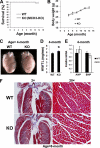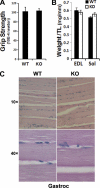Diet-induced lethality due to deletion of the Hdac3 gene in heart and skeletal muscle
- PMID: 21808063
- PMCID: PMC3190900
- DOI: 10.1074/jbc.M111.277707
Diet-induced lethality due to deletion of the Hdac3 gene in heart and skeletal muscle
Abstract
Many human diseases result from the influence of the nutritional environment on gene expression. The environment interacts with the genome by altering the epigenome, including covalent modification of nucleosomal histones. Here, we report a novel and dramatic influence of diet on the phenotype and survival of mice in which histone deacetylase 3 (Hdac3) is deleted postnatally in heart and skeletal muscle. Although embryonic deletion of myocardial Hdac3 causes major cardiomyopathy that reduces survival, we found that excision of Hdac3 in heart and muscle later in development leads to a much milder phenotype and does not reduce survival when mice are fed normal chow. Remarkably, upon switching to a high fat diet, the mice begin to die within weeks and display signs of severe hypertrophic cardiomyopathy and heart failure. Down-regulation of myocardial mitochondrial bioenergetic genes, specifically those involved in lipid metabolism, precedes the full development of cardiomyopathy, suggesting that HDAC3 is important in maintaining proper mitochondrial function. These data suggest that loss of the epigenomic modifier HDAC3 causes dietary lethality by compromising the ability of cardiac mitochondria to respond to changes of nutritional environment. In addition, this study provides a mouse model for diet-inducible heart failure.
Figures







Similar articles
-
Maintenance of cardiac energy metabolism by histone deacetylase 3 in mice.J Clin Invest. 2008 Nov;118(11):3588-97. doi: 10.1172/JCI35847. Epub 2008 Oct 1. J Clin Invest. 2008. PMID: 18830415 Free PMC article.
-
Liver-specific deletion of histone deacetylase 3 disrupts metabolic transcriptional networks.EMBO J. 2008 Apr 9;27(7):1017-28. doi: 10.1038/emboj.2008.51. Epub 2008 Mar 20. EMBO J. 2008. PMID: 18354499 Free PMC article.
-
Deletion of intestinal Hdac3 remodels the lipidome of enterocytes and protects mice from diet-induced obesity.Nat Commun. 2019 Nov 22;10(1):5291. doi: 10.1038/s41467-019-13180-8. Nat Commun. 2019. PMID: 31757939 Free PMC article.
-
Deacetylase-dependent and -independent role of HDAC3 in cardiomyopathy.J Cell Physiol. 2023 Mar;238(3):647-658. doi: 10.1002/jcp.30957. Epub 2023 Feb 6. J Cell Physiol. 2023. PMID: 36745702 Free PMC article.
-
Integrated omics approaches to characterize a nuclear receptor corepressor-associated histone deacetylase in mouse skeletal muscle.Mol Cell Endocrinol. 2018 Aug 15;471:22-32. doi: 10.1016/j.mce.2017.05.024. Epub 2017 May 26. Mol Cell Endocrinol. 2018. PMID: 28554803 Free PMC article. Review.
Cited by
-
Hdac3 Deficiency Increases Marrow Adiposity and Induces Lipid Storage and Glucocorticoid Metabolism in Osteochondroprogenitor Cells.J Bone Miner Res. 2016 Jan;31(1):116-28. doi: 10.1002/jbmr.2602. Epub 2015 Aug 20. J Bone Miner Res. 2016. PMID: 26211746 Free PMC article.
-
HDAC3 is essential for DNA replication in hematopoietic progenitor cells.J Clin Invest. 2013 Jul;123(7):3112-23. doi: 10.1172/JCI60806. Epub 2013 Jun 10. J Clin Invest. 2013. PMID: 23921131 Free PMC article.
-
CELL FATE DETERMINATION IN 3D: REGULATION OF GENE EXPRESSION VIA CHROMATIN INTERACTIONS WITH THE NUCLEAR MEMBRANE.Trans Am Clin Climatol Assoc. 2018;129:121-131. Trans Am Clin Climatol Assoc. 2018. PMID: 30166706 Free PMC article.
-
Regulation of metabolism by mitochondrial enzyme acetylation in cardiac ischemia-reperfusion injury.Biochim Biophys Acta Mol Basis Dis. 2020 Jun 1;1866(6):165728. doi: 10.1016/j.bbadis.2020.165728. Epub 2020 Feb 15. Biochim Biophys Acta Mol Basis Dis. 2020. PMID: 32068115 Free PMC article. Review.
-
Histone deacetylase 3 suppression increases PH domain and leucine-rich repeat phosphatase (Phlpp)1 expression in chondrocytes to suppress Akt signaling and matrix secretion.J Biol Chem. 2013 Apr 5;288(14):9572-9582. doi: 10.1074/jbc.M112.423723. Epub 2013 Feb 13. J Biol Chem. 2013. PMID: 23408427 Free PMC article.
References
-
- Wong C., Marwick T. H. (2007) Nat. Clin. Pract. Cardiovasc. Med. 4, 436–443 - PubMed
-
- Alpert M. A. (2001) Am. J. Med. Sci. 321, 225–236 - PubMed
-
- Lopaschuk G. D., Ussher J. R., Folmes C. D., Jaswal J. S., Stanley W. C. (2010) Physiol. Rev. 90, 207–258 - PubMed
-
- Neubauer S. (2007) N. Engl. J. Med. 356, 1140–1151 - PubMed
Publication types
MeSH terms
Substances
Grants and funding
LinkOut - more resources
Full Text Sources
Molecular Biology Databases

